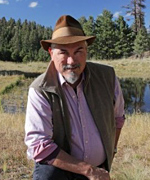—Alan Dulaney
 Apparently, water really is for fighting over.
Apparently, water really is for fighting over.
The heavy precipitation this year across the Colorado River Basin improved storage to the extent that the probability of a declared shortage in the Lower Basin in 2018 rolled back to around 30%. Lakes Powell and Mead both received much-needed inflows. Still, Lake Mead suffers from a structural deficit — more water flows out than in. These losses cannot be mitigated without cooperative efforts from all Lower Basin states. Their talks on the Drought Contingency Plan appear to have slowed down; yet the DCP remains as necessary today as it was before the snows of January. Despite this pressing need, here in Arizona, two major parties — the Arizona Department of Water Resources (ADWR) and the Central Arizona Water Conservation District (CAWCD) — have not agreed to a unified position. In fact, tensions between these players continue to escalate.
Arizona is still working on a revised internal plan, “DCP+.” ADWR believes the “system conservation concept” embedded in DCP+ will maintain Lake Mead water levels above the trigger points for declared shortage. However, achieving that goal won’t be easy. Late last year, the plan was to provide both compensated and non-compensated forbearance of water deliveries in order to leave Arizona water on Lake Mead for system conservation. Much of that original DCP+ depended on Federal funding — but the easy money ceased to flow after January 20. So ADWR is looking at new approaches to the problem while preserving the essential concept of creating a storage buffer in Lake Mead to forestall any declaration of shortage. A recent agreement between ADWR, the Gila River Indian Community, the City of Phoenix, and the Walton Foundation might provide a workable template.
CAWCD, on the other hand, cites a need for greater flexibility. Its new plan would control water elevations in Lake Mead within a narrow, 10-foot band, between 1073 and 1083 feet (1075 feet is the first trigger for shortage). This plan depends on the outcome of modeling reports from the Bureau of Reclamation in April and August. If Lake Mead levels are predicted to be below a certain elevation in the April modeling report, more water will be released from Lake Powell — up to 9 million acre-feet. Lake Mead would then theoretically be predicted to be above 1075 in the August modeling report, and shortage would not be declared for the next year. The plan would artificially create extra inflows from Powell to Mead based on a careful balancing of lake levels. It’s unclear how it would handle unregulated flows into Lake Mead (such as flows from the Little Colorado River) or unanticipated extra storage (such as surplus water that California may park on Lake Mead if they can’t store it elsewhere). Other hydrologic variables would also have to be carefully managed so lake levels could be precisely positioned.
In a recent Arizona Republic editorial, ADWR director Tom Buschatzke states his opposition to this plan in no uncertain terms. He sees the CAWCD’s approach as a short-term solution — a high-risk gamble that “lacks a fundamental aspect of credibility and statesmanship that Arizona needs to maintain with our neighbors in Wyoming, Utah, Colorado, New Mexico, Nevada, and California.” According to Buschatzke, the CAWCD plan will simply not protect Arizona’s water in Lake Mead.
The importance of the DCP cannot be overstated. This winter’s precipitation has created a window of opportunity to complete negotiations with the other Lower Basin states. The recent dispute between ADWR and CAWCD cannot be allowed to interfere with achieving a DCP agreement. Collaboration is always better than conflict in settling water matters. Arizona must present a united front in these negotiations, with one voice in the negotiations to come with the Upper Basin states.